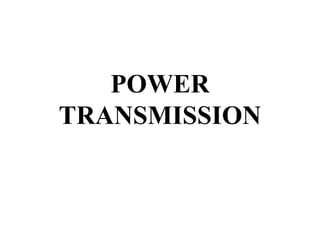
Agriculture Engineering-chptr 9 power transmission
- 2. Four basic functions of transmission systems are: 1. Select speed ratios for various travel speeds 2.Reverses the travel of the machine 3.To connect and disconnect power 4.Equalizes power to the drive wheels for turning
- 3. Five basic components of the power transmission are : i. Clutch – to connect and disconnect power ii. Gearbox system – to select speed and direction iii.Differential – to equalize power for turning iv. Final drive – to reduce speed and increase torque to axle v. Drive wheels – to propel the machine “Torque” - The effort of twisting or turning
- 4. The Clutch Provides meaning of connecting and disconnecting the engine from its load while starting, shifting or idling a) Dry clutch – standard clutch b)Hydraulic clutch – operates wet in a transmission fluid and engaged or disengaged hydraulically
- 5. Dry Clutch • The clutch operates by friction; the disks and plates must be kept perfectly dry
- 6. Engaged position Pressure plates provides pressure against clutch plate and forces plate against flywheel Power from engine transmitted to flywheel and clutch plate and transmitted to drive shaft Disengaged position Pressure on pedal pushes clutch release assembly against release levers Lever pulls pressure plate away from clutch plate and is no longer forced against flywheel Flywheel and pressure plate are free to rotate
- 7. Mechanical Transmission is a train of gears that transfer and adapts the engine power to the drive wheels of the machine the transmission can also power a special drive such as PTO (power take-off) located to the rear of the engine and clutch and in front of the differential or ring gear the gear train operates in a bath of gear oil. For special lubrication, oil sprays or feeder lines from oil pumps are sometimes used
- 8. The Differentials Does two jobs: Transmit power “around the corner” to the drive axles Allows each drive wheels to rotate at different speed and still propel its own load Ring Gear and Bevel Gears: Direct the power to the axles Bevel pinions give the differential action
- 9. The Final Drives / Final Gear Reduction • The final drive is the last phase of the power train • It gives the final reduction in speed and increased in torque to the drive wheels • Mounted near the drive wheels to avoid the stress of long axle shaft • By reducing speeds, the final drives lower the stress and simplify the transmission, since extra gears and shafts can be eliminated
- 10. Power Take-Off (PTO) – Construction & Operation • Is an attachment in the power train of a machine. It drives auxiliary equipment • Normally gear driven from the transmission and send power through a shaft to the PTO outlet where the driven equipment is coupled • Drive equipment at standard speed of 540 – 1000 rpm • Operated by a clutch release, which is sometimes part of the main engine clutch
- 11. 3 Types of PTO 1. PTO, Normal Type PTO takes its rotation from the engine through the same clutch as the gearbox therefore engaging the clutch starts both the tractor and the PTO
- 12. 2. PTO, Live type Clutch of the dual plate type controlled progressively by a pedal One clutch plate drives the gearbox and the other drives the PTO To disengage gearbox, press pedal halfway through its travel. To disengage PTO, press pedal to the bottom of its travel By pressing halfway, it is possible to leave PTO turning and at the same time stopping the tractor
- 13. 3.PTO, Fully independent type Tractor provided with 2 clutches, one for gearbox and the other for PTO 2 clutches controlled by pedal and lever. It is possible to stop the PTO leaving the tractor moving
- 14. Tractor Wheels • Tractor wheels are made of cast iron or steel. Most rear wheels have inner cast iron disks and hubs with steel rims • Most front wheels are made of steel but some are constructed with inner cast iron wheels and steel outer rims
- 15. Tires There are many different types of tractor tires, each suited to a specific operation. Tires vary in construction and tread design.
- 16. a) Rear Tires Four kinds of rear tire treads Standard or general purpose cleat familiar with “V” tread are a compromise among traction, flotation and tread life. Best all round tire for majority of farm uses High cleat provides maximum traction in mud but tread wears rapidly if operated on hard ground or paved surfaces
- 17. Nondirectional Gives good traction and flotation in loose or sandy soil. Provides sideslip control on slopes, smoother ride, and longer wear on hard surfaced and leaves no imprint on lawns Industrial Lug for on and off the road utility tractors for earthmoving the short wide bars give more contact area for longer tread wear, more traction than nondirectional tread
- 18. b) Front Tires Comes in a variety of tread designs to provide the best steering control Single rib effective where loose soil makes steering a problem Double rib and triple rib found on many general purpose tractors. Gives good steering control in average soil condition without excessive soil compaction
- 19. Flotation used where soil compaction is a problem tires are wider and have a lower profile than other front tires. While reducing compaction, these tires also make steering more difficult
- 20. Rice tread used where field conditions are exceptionally wet. Usually have 2 or 3 deep ribs for better steering control and to help tire the tire roll through muddy soil
- 21. Angle bar similar to those on the rear of the tractor used on tractors with front wheel drive and may either standard cleats or cane or rice cleats
- 22. THANK YOU